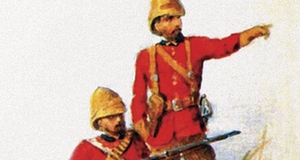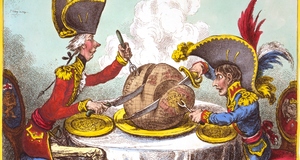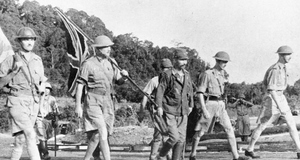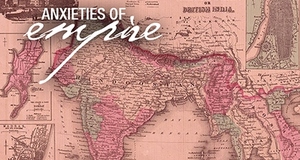|
Featured Article: Rudyard Kipling's Literary and Historical Legacy
Fowler’s one-volume History cannot cover everything in one volume. Some author or work will suffer, or another will receive more attention than what is due. The book is divided by period and genre, with subdivisions on a particular aspect like Gothic fiction, multi-plot novels, and stylistic analysis. However, Fowler should document his critical opinions, since the work contains no notes. The volume also needs supplementary material, as in Legouis and Camazian’s History. Fowler’s History intends to be comprehensive, but what suffers with some authors is depth.
Karl Beckson, in The Columbia History of British Poetry (1994), discusses Kipling in the context of “the 1890s.” The chapter is an overview of English literature in late Victorian Britain. Beckson mentions Kipling under the subheading of “continuities of Victorianism,” arguing that his work is an extension of “the noble expression of moral vision” in Victorian poetry (505). Beckson makes no room for those works that do not fit his pigeonholing. Except for Wilde and Hardy, the other authors discussed here are minor. As an overview, the chapter seems comprehensive of the period but feels fragmented. Beckson considers Kipling the poet laureate of the British Empire (507); he discusses imperial subjects in “The Widow at Windsor,” “Danny Deever,” “Mandalay,” “Recessional,” “White Man’s Burden,” and “Tommy” (507-10) and calls them “strikingly realistic” (508). No non-imperial poetry appears, such as the popular “If.” Like Daiches, Beckson notes an anti-imperial strain in “Recessional,” which “cautions Britons against pride in imperialistic power” (509). The poem’s Biblical allusions “provide a warning that the Empire itself could meet a similar fate, a possibility that haunted late-nineteenth century Victorians” (Beckson 509). The rest of the book omits analysis of Kipling’s poetry that is either outside the 1890s or outside the Empire.
The edited volume consists of essays on various aspects of British poetry from the medieval period. It seems comprehensive but gives unequal weight to some authors; for example, Chaucer, Milton, Blake, and Coleridge are discussed in separate essays. However, some critics, although usually experts in their field, have their own slant on the period or author under discussion. These critics are authoritative but biased and often repeat current scholarship. Excellent biographies and first editions of authors appear in appendices, but Kipling’s biography contains an error (possibly typographical): he received his Nobel in literature in 1907, not 1909 (657).
Ronald Carter and John McRae’s one-volume The Routledge History of English Literature (1997) discusses Kipling in the context of Victorian poetry, in a chapter on the nineteenth century. However, they analyze more than his poetry in their one-page discussion, as opposed to three or more pages each on Tennyson, the Brownings, Arnold, Hopkins, and the Pre-Raphaelites. The authors discuss only “If” and “Gunga Din,” not even “Recessional,” which Kipling considered his best poem (Young 514). They consider him more Victorian than modern (322), a view neither Fowler (1987) nor Baldick (2004) holds. They also state that “[Kipling’s] novels Plain Tales from the Hills (1888) and Kim (1901) are usually read as children’s stories” (322). However, Plain Tales is a short-story collection for adults (322). Recent scholarship is also reevaluating the opinion that these works “represent the colonial sentimentality alone” (322). The authors then elevate The Jungle Book (1894) as “a vital text in establishing a colonial ethos” (322). This may have been true then (e.g. the Boy Scouts), but although critiqued for its portrait of “the law” and colonial duty, The Jungle Book is more a children’s work than either Kim or Plain Tales. Carter and McRae’s appraisal of Kipling is inadequate. They discuss the works they consider important in one page and Tennyson’s poetry alone in four, even if Kipling is a minor figure by comparison.
Like Fowler’s History, it is difficult to obtain both breadth and depth in one volume, since some authors or works will receive more, or less, treatment than probably deserved. However, the authors’ division of historical and literary periods, as well as their discussions of genres and major authors, separately, within those periods is sound. The volume contains an excellent timeline, which contextualizes authors and their works, and bibliography. It also includes “language notes,” to show changes in English language over time, such as the expanding lexicon, the language of Bible, Wordsworth’s “real language of men,” and the use of dialect in Hardy’s novels.
Literary historians over the past century cannot agree on how much of the British Empire influences Kipling’s oeuvre. In each literary-historical period, different authors hold different views on where Kipling fits into the established canon and which works are of literary value. Later critics and historians are also emphasizing Kipling’s longer works while the earlier ones prefer his poetry, even though few name specific poems. The crux is Kipling’s imperialism. When history places a taboo on holding an imperial outlook, many of Kipling’s longer works are slighted. However, later historians see less of an imperial stance in Kipling’s oeuvre. Some show an awareness of literary criticism during their respective time period and some do not. Although Kipling will always be considered a writer of empire, recent criticism is reevaluating his problematic placement within the oeuvre of late Victorian and early modern imperial literature.
- Baldick, Chris. The Modern Movement, 1910-1940. The Oxford English Literary History. Ed. Jonathan Bate. Vol. 10. Oxford, UK: Oxford UP, 2004.
- Beckson, Karl. “The 1890s.” The Columbia History of British Poetry. Eds. Carl Woodring and James Shapiro. New York: Columbia UP, 1994. 505-31.
- Bhatia, Nandi. “Kipling’s Burden: Representing Colonial Authority and Constructing the ‘Other’ through Kimball O’Hara and Babu Hurree Chunder in Kim.” South Asia Graduate Research Journal 1 (1994): 1-8.
- Birkenhead, Robin, Lord. Rudyard Kipling. New York: RandomHouse, 1978.
- Carter, Ronald and John McRae. The Routledge History of Literature in English: Britain and Ireland. London: Routledge, 1997.
- Chaudhuri, Nirad C. “The Finest Story about India -- in English.” Encounter Apr. 1957. Rpt in The Age of Kipling. Ed. John Gross. New York: Simon & Schuster, 1972. 27-35.
- Chew, Samuel C. and Richard D. Altick. The Nineteenth Century and After (1789-1939). A Literary History of England. Ed. Albert C. Baugh. 2nd ed. Vol. 4. New York: Appleton-Century-Crofts, 1967.
- Daiches, David. A Critical History of English Literature. 2nd ed. Vol. 4. London: Secker and Warburg, 1969.
- Fowler, Alistair. A History of English Literature. Cambridge, MA: Harvard UP, 1987.
- Gilmour, David. The Long Recessional: The Imperial Life of Rudyard Kipling. New York: Farrar, Straus, & Giroux, 2002.
- Hubel, Teresa. Whose India?: The Independence Struggle in British and Indian Fiction and History. Durham, NC: DukeUP, 1996.
- Karlin, Danny. “Plain Tales?” Kipling Considered. Ed. Phillip Mallett. New York: St. Martin’s, 1989. 1-18.
- Kemp, Sandra. Kipling’s Hidden Narratives. Oxford, UK: BasilBlackwell, 1988.
- King, Blair B. “Kim in Historical Context.” Kim. Ed. ZohrehT. Sullivan. Norton Critical Editions. New York: Norton, 2002. 297-309.
- Legouis, Emile, and Louis Cazamian. A History of English Literature. Trans. Helen Douglas Irvine, W. D. MacInnes, and Louis Cazamian. 2nd ed. New York: Macmillan, 1935.
- Mallett, Phillip, ed. Kipling Considered. New York: St.Martin’s, 1989.
- McBratney, John. “Images of Indian Women in Rudyard Kipling: A Case of Doubling Discourse.” Center for Cultural Studies 7 Dec. 1998. 20 Oct. 2004.
- Moore-Gilbert, Bart. “Reading Kipling, Reading Bhabha.” Writing India, 1757-1990: The Literature of British India. Ed. Bart Moore-Gilbert. Manchester, UK: Manchester UP, 1996. 111-38.
- Paffard, Mark. Kipling’s Indian Fiction. New York: St.Martin’s, 1989.
- Park, Clara Claiborne. “The River and The Road: Fashions in Forgiveness.” The American Scholar 66 (1997): 43-62.
- Prescott, Lynda. “The White Man’s Burden: Kim.” Literature and Nation: Britain and India, 1800-1990. Eds. Richard Allen and Harish Trivedi. London: Routledge, 2000. 67‑77.
- Reiss, Timothy J. “Mapping Identities: Literature, Nationalism, and Colonialism.” American Literary History 4 (1992): 649-77.
- Roy, Parama. Indian Traffic: Identities in Question in Colonial and Postcolonial India. Berkeley: U of California P, 1998.
- Said, Edward. Culture and Imperialism. New York: Knopf, 1993.
- Stewart, J. I. M. Eight Modern Writers. The Oxford History of English Literature. Eds. F. P. Wilson and Bonamy Dobree. Vol. 12. Oxford, UK: Oxford UP, 1963.
- Suleri, Sara. The Rhetoric of English India. Chicago: U of Chicago P, 1992.
- Warren, T. Herbert. “South African Poetry.” The Nineteenth Century III. The Cambridge History of English Literature. Eds. A. W. Ward and A. R. Waller. Vol. 14. New York: Macmillan, 1917. 414‑24.
- Williams, Patrick. “Kim and Orientalism.” Kipling Considered. Ed. Phillip Mallett. New York: St. Martins, 1989. 33-55. a
- Wilson, Angus. The Strange Ride of Rudyard Kipling: His Life and Works. New York: Viking, 1978.
- Young, G. M. “Joseph (Rudyard) Kipling.” The Dictionary of National Biography, 1931‑1940. Ed. L. G. Wickham Legg. Oxford, UK: Oxford UP, 1949. 512‑16.
1.) See Lord Birkenhead, Rudyard Kipling (1978), 292, 328-29; and Young, “Joseph (Rudyard) Kipling,” The Dictionary of National Biography (1949), 513.
2.) The Oxford History of English Literature, eds. F. P. Wilson and Bonamy Dobree, vol. 12.
3.) See Clara Claiborne Park, “The River and the Road,” 44-45, 62; Lynda Prescott, “The White Man’s Burden: Kim,” 67; and Parama Roy, Indian Traffic, 79. Nirad Chaudhuri (1957) calls Kim “the finest novel [of India] in English” (28).
4.) See Nandi Bhatia (1994), Teresa Hubel (1996), Blair King (2002), Clara Park (1997), Lynda Prescott (2000), Timothy Reiss (1992), Parama Roy (1998), Edward Said (1993), Sara Suleri (1992), and Patrick Williams (1989).
5.) A Literary History of England, ed. Albert C. Baugh, 2nd ed., vol. 4.
6.) See, for example, Phillip Mallett, ed., Kipling Considered (1989); and Mark Paffard, Kipling’s Indian Fiction (1989).
7.) See footnotes 3 and 4.
8.) The Norton Anthology of English Literature, 6th ed., vol. 2, 1674‑78.
9.) See, for example, Danny Karlin, “Plain Tales?” (1989); Sandra Kemp, Kipling’s Hidden Narratives, 1988; Bart Moore-Gilbert, “Reading Kipling, Reading Bhabha,” 1996; and Mark Paffard, Kipling’s Indian Fiction, 1989.
10.) See, for example, John McBratney (1998) and Edward Said (1993).
11.) Legouis and Cazamian, A History of English Literature (1935), describe both Captains Courageous and Stalky and Co., in a footnote on Kipling’s life and work, as “tales for the young” (1334n1).
12.) See, for example, Angus Wilson, The Strange Ride of Rudyard Kipling (1978), 205.
13.) See, for example, Ricketts, “Kipling and the War,” 1986; and Page, “What Happens in ‘Mary Postgate’?” (1986).
14.) See, for example, Karlin, “Plain Tales?” (1989); Kemp, Kipling’s Hidden Narratives, 1988; Mallett, ed., Kipling Considered, 1989; McBratney, Imperial Subjects, Imperial Space, 2002; and Paffard, Kipling’s Indian Fiction, 1989.
15.) David Gilmour, The Long Recessional (2002), said that in a recent BBC poll, “If” was “Britain’s favourite poem” (xi).
16.) See Lord Birkenhead, Rudyard Kipling (1978), 248-51. See also G. M. Young, “Joseph (Rudyard) Kipling,” The Dictionary of National Biography (1949), 514.
17.) See his chapter on “Modernist Fiction” (311-42).
18.) Chris Baldick, The Modern Movement, 1910-1940 (2004), vol. 10 of The Oxford English Literary History.
- Baldick, Chris. The Modern Movement, 1910-1940. The Oxford English Literary History. Ed. Jonathan Bate. Vol. 10. Oxford, UK: Oxford UP, 2004.
- Beckson, Karl. “The 1890s.” The Columbia History of British Poetry. Eds. Carl Woodring and James Shapiro. New York: Columbia UP, 1994. 505-31.
- Bhatia, Nandi. “Kipling’s Burden: Representing Colonial Authority and Constructing the ‘Other’ through Kimball O’Hara and Babu Hurree Chunder in Kim.” South Asia Graduate Research Journal 1 (1994): 1-8.
- Birkenhead, Robin, Lord. Rudyard Kipling. New York: RandomHouse, 1978.
- Carter, Ronald and John McRae. The Routledge History of Literature in English: Britain and Ireland. London: Routledge, 1997.
- Chaudhuri, Nirad C. “The Finest Story about India -- in English.” Encounter Apr. 1957. Rpt in The Age of Kipling. Ed. John Gross. New York: Simon & Schuster, 1972. 27-35.
- Chew, Samuel C. and Richard D. Altick. The Nineteenth Century and After (1789-1939). A Literary History of England. Ed. Albert C. Baugh. 2nd ed. Vol. 4. New York: Appleton-Century-Crofts, 1967.
- Daiches, David. A Critical History of English Literature. 2nd ed. Vol. 4. London: Secker and Warburg, 1969.
- Fowler, Alistair. A History of English Literature. Cambridge, MA: Harvard UP, 1987.
- Gilmour, David. The Long Recessional: The Imperial Life of Rudyard Kipling. New York: Farrar, Straus, & Giroux, 2002.
- Hubel, Teresa. Whose India?: The Independence Struggle in British and Indian Fiction and History. Durham, NC: DukeUP, 1996.
- Karlin, Danny. “Plain Tales?” Kipling Considered. Ed. Phillip Mallett. New York: St. Martin’s, 1989. 1-18.
- Kemp, Sandra. Kipling’s Hidden Narratives. Oxford, UK: BasilBlackwell, 1988.
- King, Blair B. “Kim in Historical Context.” Kim. Ed. ZohrehT. Sullivan. Norton Critical Editions. New York: Norton, 2002. 297-309.
- Legouis, Emile, and Louis Cazamian. A History of English Literature. Trans. Helen Douglas Irvine, W. D. MacInnes, and Louis Cazamian. 2nd ed. New York: Macmillan, 1935.
- Mallett, Phillip, ed. Kipling Considered. New York: St.Martin’s, 1989.
- McBratney, John. “Images of Indian Women in Rudyard Kipling: A Case of Doubling Discourse.” Center for Cultural Studies 7 Dec. 1998. 20 Oct. 2004.
- Moore-Gilbert, Bart. “Reading Kipling, Reading Bhabha.” Writing India, 1757-1990: The Literature of British India. Ed. Bart Moore-Gilbert. Manchester, UK: Manchester UP, 1996. 111-38.
- Paffard, Mark. Kipling’s Indian Fiction. New York: St.Martin’s, 1989.
- Park, Clara Claiborne. “The River and The Road: Fashions in Forgiveness.” The American Scholar 66 (1997): 43-62.
- Prescott, Lynda. “The White Man’s Burden: Kim.” Literature and Nation: Britain and India, 1800-1990. Eds. Richard Allen and Harish Trivedi. London: Routledge, 2000. 67‑77.
- Reiss, Timothy J. “Mapping Identities: Literature, Nationalism, and Colonialism.” American Literary History 4 (1992): 649-77.
- Roy, Parama. Indian Traffic: Identities in Question in Colonial and Postcolonial India. Berkeley: U of California P, 1998.
- Said, Edward. Culture and Imperialism. New York: Knopf, 1993.
- Stewart, J. I. M. Eight Modern Writers. The Oxford History of English Literature. Eds. F. P. Wilson and Bonamy Dobree. Vol. 12. Oxford, UK: Oxford UP, 1963.
- Suleri, Sara. The Rhetoric of English India. Chicago: U of Chicago P, 1992.
- Warren, T. Herbert. “South African Poetry.” The Nineteenth Century III. The Cambridge History of English Literature. Eds. A. W. Ward and A. R. Waller. Vol. 14. New York: Macmillan, 1917. 414‑24.
- Williams, Patrick. “Kim and Orientalism.” Kipling Considered. Ed. Phillip Mallett. New York: St. Martins, 1989. 33-55. a
- Wilson, Angus. The Strange Ride of Rudyard Kipling: His Life and Works. New York: Viking, 1978.
- Young, G. M. “Joseph (Rudyard) Kipling.” The Dictionary of National Biography, 1931‑1940. Ed. L. G. Wickham Legg. Oxford, UK: Oxford UP, 1949. 512‑16.
Endnotes
1.) See Lord Birkenhead, Rudyard Kipling (1978), 292, 328-29; and Young, “Joseph (Rudyard) Kipling,” The Dictionary of National Biography (1949), 513.
2.) The Oxford History of English Literature, eds. F. P. Wilson and Bonamy Dobree, vol. 12.
3.) See Clara Claiborne Park, “The River and the Road,” 44-45, 62; Lynda Prescott, “The White Man’s Burden: Kim,” 67; and Parama Roy, Indian Traffic, 79. Nirad Chaudhuri (1957) calls Kim “the finest novel [of India] in English” (28).
4.) See Nandi Bhatia (1994), Teresa Hubel (1996), Blair King (2002), Clara Park (1997), Lynda Prescott (2000), Timothy Reiss (1992), Parama Roy (1998), Edward Said (1993), Sara Suleri (1992), and Patrick Williams (1989).
5.) A Literary History of England, ed. Albert C. Baugh, 2nd ed., vol. 4.
6.) See, for example, Phillip Mallett, ed., Kipling Considered (1989); and Mark Paffard, Kipling’s Indian Fiction (1989).
7.) See footnotes 3 and 4.
8.) The Norton Anthology of English Literature, 6th ed., vol. 2, 1674‑78.
9.) See, for example, Danny Karlin, “Plain Tales?” (1989); Sandra Kemp, Kipling’s Hidden Narratives, 1988; Bart Moore-Gilbert, “Reading Kipling, Reading Bhabha,” 1996; and Mark Paffard, Kipling’s Indian Fiction, 1989.
10.) See, for example, John McBratney (1998) and Edward Said (1993).
11.) Legouis and Cazamian, A History of English Literature (1935), describe both Captains Courageous and Stalky and Co., in a footnote on Kipling’s life and work, as “tales for the young” (1334n1).
12.) See, for example, Angus Wilson, The Strange Ride of Rudyard Kipling (1978), 205.
13.) See, for example, Ricketts, “Kipling and the War,” 1986; and Page, “What Happens in ‘Mary Postgate’?” (1986).
14.) See, for example, Karlin, “Plain Tales?” (1989); Kemp, Kipling’s Hidden Narratives, 1988; Mallett, ed., Kipling Considered, 1989; McBratney, Imperial Subjects, Imperial Space, 2002; and Paffard, Kipling’s Indian Fiction, 1989.
15.) David Gilmour, The Long Recessional (2002), said that in a recent BBC poll, “If” was “Britain’s favourite poem” (xi).
16.) See Lord Birkenhead, Rudyard Kipling (1978), 248-51. See also G. M. Young, “Joseph (Rudyard) Kipling,” The Dictionary of National Biography (1949), 514.
17.) See his chapter on “Modernist Fiction” (311-42).
18.) Chris Baldick, The Modern Movement, 1910-1940 (2004), vol. 10 of The Oxford English Literary History.
Suggested Reading from Inquiries Journal
“The Man Who Would Be King” (1888)[1] is one of Rudyard Kipling’s most well known and highly acclaimed short stories. Michael Caine, Sean Connery, and Christopher Plummer starred in John Huston’s classic film adaptation (1975), which provided a testament to the story’s enduring popularity (Beckerman... MORE»
The ‘civilising mission' is a broad ideology that combines four main ideals; Enlightenment ideals, Christian / Evangelical ideas of pre-destination, racist ideas about white superiority and Liberalism. All these ideals... MORE»
Since the end of the Second World War, scholars of British military history have busied themselves with attempts to explain the British defeat at Singapore to Japan in February 1942. Research reveals that there existed what... MORE»
In May 2012, Shakil Afridi received a sentence of thirty-three years “rigorous imprisonment” and a large fine for aiding foreign intelligence gatherers in their quest for Osama bin Laden. The Pakistani state did not charge Afridi – a doctor from the Khyber area of the Federally Administered Tribal Areas (FATA) &... MORE»
Latest in Literature
2023, Vol. 15 No. 02
This literary analysis compares the spiritual landscape of Aldous Huxley’s Brave New World against his nonfiction work, The Perennial Philosophy. In Brave New World, Huxley’s World State appears spiritually promising. It embeds self-... Read Article »
2022, Vol. 14 No. 09
Woolfian Scholars regularly denote the moments where Woolf’s characters feel inexplicably connected and inseparable from one another as representing the spiritual and mystic beliefs of their author. I want to reframe this notion, considering... Read Article »
2022, Vol. 14 No. 09
The Goldfinch (2013) by Donna Tartt is a novel that explores the conditions of grief and escalating lengths characters will go to survive the traumas and mysteries of life. This story of guilt and loss—intermixed with love and longing&mdash... Read Article »
2022, Vol. 14 No. 04
British Poet Laureate Carol Ann Duffy’s The World’s Wife presents a fresh outlook on myths and fairy tales, by retelling them through sociosexually liberated women. The poems feature many themes such as murder, sexuality and childhood... Read Article »
2022, Vol. 14 No. 04
The 17th and 18th centuries saw a wide proliferation of aesthetic discourse through which the picturesque emerged to capture the type of beauty derived from the exchange of in vivo vigor for the spirit of artistic medium. While the metaphysical... Read Article »
2022, Vol. 14 No. 03
This paper explores the complexity of Whitman’s nationalism and, with reference to Leaves of Grass (1856), examines the apparent paradox between Whitman’s poetry of love and recognition and his imperialistic impulses. This paper draws... Read Article »
2022, Vol. 14 No. 02
This article explores the expression of the Gothic romance genre in the 21st century, by examining Mike Flannagan’s The Haunting of Bly Manor. Very little literature focuses on contemporary expressions of this genre. The Gothic reflects the... Read Article »
|



















